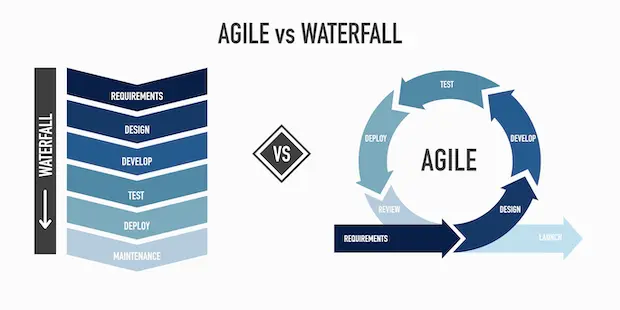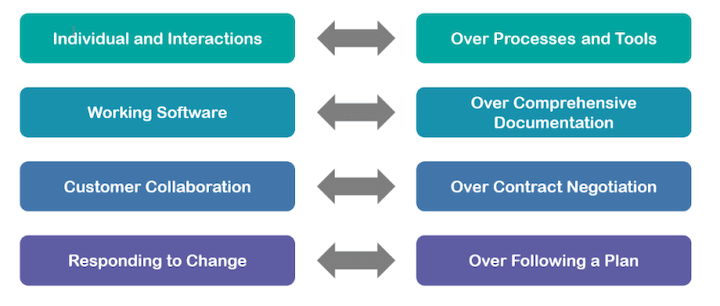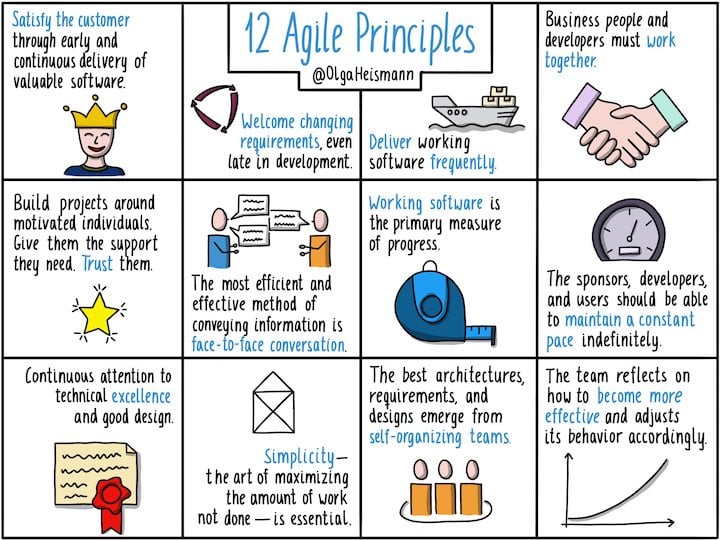The Agile Manifesto marked the birth of Agile, a professional worldview that has sparked innovation in ways the authors didn’t expect and reached far beyond the world of software.
The Agile Manifesto specifies four values that guide its principles for efficient software product development. The four values of the Agile Manifesto are:
- Individuals and interactions over processes and tools
- Working software over comprehensive documentation
- Customer collaboration over contract negotiation
- Responding to change over following a plan
In this guide, we’ll introduce you to the concept of agile product development and then break down the Agile Manifesto with a focus on its four values.
Table of contents
- What is Agile?
- What is the Agile Manifesto?
- A brief history
- Breaking down the Agile Manifesto
- The four Agile Manifesto values
What is Agile?
Agile is a mindset and philosophy around building products that espouses collaboration, customer-centricity, and expecting and responding to change.
A common misconception is that Agile is about development speed or velocity; it isn’t. Also counter to popular belief, Agile is neither a methodology nor a framework. These labels are reserved for more specific and prescriptive Agile models.
For instance, scrum is an example of a popular Agile “framework” — a set of instructions for putting the Agile values and principles into practice. Thought leaders and consultancies create many Agile models. These frameworks should not be confused with Agile itself.
What is the Agile Manifesto?
The Agile Manifesto is a short, 68-word statement that establishes a broad system of purpose and values for meaningful, efficient, continuous software development:
We are uncovering better ways of developing software by doing it and helping others do it. Through this work we have come to value:
- Individuals and interactions over processes and tools
- Working software over comprehensive documentation
- Customer collaboration over contract negotiation
- Responding to change over following a plan
That is, while there is value in the items on the right, we value the items on the left more.
Don’t let the statement’s brevity fool you; these words pack a punch. The Agile Manifesto has changed the tech world and impacted how teams work across all industries, not only software.
A brief history
The Agile Manifesto established the concept of agile product development. The brief but bold declaration was written and signed in 2001 by 17 seasoned software engineers, some of whom have been writing code since the 1960s and ’70s. The machines and programming languages available at the time were as slow as the businesses they supported. Computers served elite science use cases more than business.
Throughout the 1970s and ’80s, waterfall, or “heavyweight,” practices dominated product development, where the emphasis was placed on upfront planning and documentation. Entering the new millennium, these experts had been collaborating on what were called at the time “lightweight” software development practices.

Popular lightweight frameworks of the 1990s were crystal, extreme programming, and scrum, the most popular framework today. The creators of these leading frameworks and others were all signatories of the Agile Manifesto.
Today, Agile is the standard. It all started with the Agile Manifesto.
Breaking down the Agile Manifesto
The Agile Manifesto consists of a simple preamble, four values, and one clarifying sentence. Let’s dig into each element and unpack what it means in more detail.
Preamble: Continuous learning is critical
The first sentence of the Agile Manifesto is the most overlooked and understated. Though seemingly insignificant, the signers have said this preamble actually took a considerable amount of time to write.
People often reference the four values without considering the introduction, but it’s important to establish a philosophy of constant change and improvement as well as generosity:
We are uncovering better ways of developing software by doing it and helping others do it.
Let’s get even more granular and zoom in on the first five words of the Agile Manifesto: “We are uncovering better ways….”
To embrace the Agile Manifesto means to commit to continuous improvement — in other words, to be joyfully and perpetually dissatisfied. From there, we should remember how much the discoveries of others have helped us. Share learnings; there are always new learnings to be had.
I’ve seen this play out in retrospectives, postmortems, manager and/or peer feedback, evolving processes, and definitions of done (DoDs) — sharing learnings and listening to the understandings of others is crucial to any agile project. If you look around and see a lot of process that has gone unchanged for some time, you probably haven’t been “uncovering better ways.”
The world changes and life changes. To be agile means to embrace change and continuous learning.
The twist at the end
Throughout the four value statements, it can be easy to forget that none of these things are bad. The point of an even over statement is that one part is good, but the other is even better.
Before we dig into the four values, let’s skip to the bit at the end, where the Agile Manifesto tells us how to read the values correctly. This is also important but often forgotten:
That is, while there is value in the items on the right, we value the items on the left more.
As we review the four agile manifesto values, we should recognize that the right side is good, but the left is even more valuable.

The four Agile Manifesto values
1. Individuals and interactions over processes and tools
To be agile means to be all-in on people. The first value of the Agile Manifesto might be the most ahead of its time. The authors knew that people mattered and collaboration was essential.
We can infer more about the intention here by looking at the 12 Agile Principles, which are an elaboration of the fundamental values.

Of the 12 Agile Principles, at least six involve human relationships:
- Principle No. 4 establishes a new kind of relationship where “business people and developers must work together daily”
- Principle No. 5 says to “build projects around motivated individuals. Give them the environment and support they need”
- Principle No. 6 asserts that “face-to-face conversation” is the best way to communicate
- Principle No. 8 introduces the symbiotic relationship between “sponsors, developers, and users”
- Principle No. 11 claims the best deliverables come from “self-organizing teams”
- Principle No. 12 encourages teams to “[reflect] on how to become more effective” and adjust accordingly
It’s critical to remember how these even over statements should be interpreted. The right side of the statement (processes and tools) is valuable. However, individuals and interactions are more valuable. To rephrase this first Agile Manifesto value, we might say, “Processes and tools are good, but individuals and their interactions are even more important.”
In the real world, I’ve seen this play out in cross-functional squads made up of product, engineering, design, quality assurance, data analytics, and even marketing stakeholders — working day after day, in a single team, on a customer problem.
2. Working software over comprehensive documentation
While the first Agile Manifesto value is probably the most foundational of the four, the second value might be the most controversial today. The emphasis on “working software” often alarms modern tech professionals. What is so great about software that only “works?”
I have a friend who is a product manager at a large company. While developing their product, they spent up to a year digging into user research and discussing customer insights without shipping anything to the customer. In the end, they produced a small, insignificant feature that didn’t meet any real customer need.
So in cases like these, everyone wants to be a philosopher and empathize with customers, but no one can actually deliver.
Getting a minimum viable product (MVP) out now is better than getting a “perfect” product out much later. Of course, a “working” product is not the end goal, but it is required for delivering value to customers and businesses. If we’re not shipping, then what are we actually accomplishing?
Comprehensive documentation is good, according to the Agile Manifesto. This is how the even over statements work. For example, the second value could be rephrased as, “Documentation is good, but delivering working software is even more important.” A product with no documentation is preferable to having documentation and no product.
3. Customer collaboration over contract negotiation
In the third Agile Manifesto value, the reference to “contract negotiation” tends to perplex some readers. Keep in mind that the right side of the statement is still valuable, so contract negotiation is good. But what is this contract negotiation that we’re talking about?
Contract negotiation refers to any agreements involved in the work, internally or externally. Yes, this includes any political dealings and vendor paperwork, but there’s more to it than that. Many agile professionals would interpret contract negotiations to also include deadlines, budget agreements, and scope agreements with internal stakeholders or customers.
A modern paraphrase might be, “Business commitments are good, but the voice of the customer should come first.”
I’ve seen Agile teams live out this value by prioritizing research and discovery work ahead of execution to ensure the right solution is built. I’ve seen granular Gantt charts replaced with quarterly and monthly Gantt charts or higher-level Now-Next-Later roadmaps.
4. Responding to change over following a plan
The fourth and final Agile Manifesto value asserts that following a plan is good, but responding to change is even more valuable.
Before the lightweight frameworks of the 1980s and ’90s, organizations might’ve spent years planning a solution, then years building the solution. By the time the original solution was ready, the problem had evolved enough to render the solution useless. These types of experiences and observations led engineers to seek better ways of developing software.
A well-known quote from former U.S. president Dwight Eisenhower comes to mind: “Plans are nothing; planning is everything.” The point is that plans are good to work on, but they should always consider the constant uncertainty surrounding them. Plans are only as good as their flexibility.
Is the Agile Manifesto still relevant today?
I believe the Agile Manifesto has aged quite well, all things considered. It is still a set of values that offers a healthy challenge for tech and business professionals alike.
Not only does the Agile Manifesto remain helpful, but many other industries outside of software development have adopted it. Simply tweaking a few references to “software” has gone a long way toward helping marketing teams, human resources, and many others to deliver valuable outcomes more efficiently.
Despite dozens of Agile Manifesto alternatives, extensions, and calls for complete replacement, the general consensus is that the document has stood the test of time remarkably well. Arguments from critics are often misguided, unconvincing, or just not adding enough value to get widespread attention. There is so much content out there now, a new Agile Manifesto would need to be revolutionary to get traction.
Agile Manifesto TL;DR summary
To summarize the key takeaways from this Agile Manifesto guide:
- The preamble, which is the most overlooked part of the manifesto, encourages continually “uncovering better ways” and “helping others” along the way
- Value No. 1 is the most ahead of its time and places people, collaboration, inclusion, and relationships at the center of Agile. To paraphrase this value for modern software development: Processes and tools are valuable, but people and relationships are even more important
- Value No. 2 is the most controversial today because it espouses “working software over comprehensive documentation.” Modern paraphrase: Robust documentation is good, but actually delivering solutions is better
- Value No. 3 is the most misunderstood due to “contract negotiation” and vagueness around “customer”. Modern paraphrase: Commitments are good, but building the right thing is better.
- Value No. 4 is the heart of Agile: “Responding to change over following a plan”
The post Agile explained: The four Agile Manifesto values appeared first on LogRocket Blog.
from LogRocket Blog https://ift.tt/0vqdtID
via Read more



